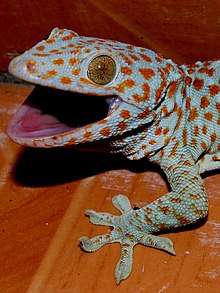Gekkonidae
Gekkonidae (the common geckos) is the largest family of geckos, containing over 950 described species in 64 genera.[1][2][3][4][5][6] This family comprises many of the most widespread gecko species, including house geckos (Hemidactylus), tokay geckos (Gekko), day geckos (Phelsuma), mourning geckos (Lepidodactylus) and dtellas (Gehyra). Gekkonid geckos occur globally and are particularly species-rich in tropical areas.
| Gekkonidae | |
|---|---|
 | |
| Tokay gecko (Gekko gecko) | |
| Scientific classification | |
| Kingdom: | Animalia |
| Phylum: | Chordata |
| Class: | Reptilia |
| Order: | Squamata |
| Superfamily: | Gekkonoidea |
| Family: | Gekkonidae Gray, 1825 |
| Genera | |
|
See text | |
Evolution
They evolved probably in the Lower Cretaceous and some 100 million years ago they were already well adapted for a scansorial lifestyle.[7]
Genera
Gekkonidae contains the following genera:
- Afroedura (28 species)
- Afrogecko (2 species)
- Agamura (2 species)
- Ailuronyx (3 species)
- Alsophylax (6 species)
- Altiphylax (5 species)
- Blaesodactylus (6 species)
- Bunopus (3 species)
- Calodactylodes (2 species)
- †Cadurcogekko (2 species)
- Chondrodactylus (6 species)
- Christinus (3 species)
- Cnemaspis (153 species)
- Crossobamon (2 species)
- Cryptactites – Peringuey's leaf-toed gecko
- Cyrtodactylus (286 species)
- Cyrtopodion (24 species)
- Dactylocnemis – Pacific gecko
- Dixonius (8 species)
- Dravidogecko (7 species)
- Ebenavia (6 species)
- Elasmodactylus (2 species)
- Geckolepis (5 species)
- Gehyra (67 species)
- Gekko (77 species)
- Goggia (10 species)
- Hemidactylus (168 species)
- Hemiphyllodactylus (41 species)
- Heteronotia (5 species)
- Homopholis (4 species)
- Kolekanos (1 species)
- Lakigecko (1 species)
- Lepidodactylus (39 species)
- Luperosaurus (9 species)
- Lygodactylus (69 species)
- Matoatoa (2 species)
- Mediodactylus (17 species)
- Microgecko (7 species)
- Mokopirirakau (4 species)
- Nactus (12 species)
- Naultinus (8 species) – green geckos
- Narudasia - festive gecko
- Pachydactylus (57 species)
- Paragehyra (4 species)
- Paroedura (22 species) – Madagascar ground geckos
- Parsigecko – Ziaie's Pars-gecko
- Perochirus (3 species)
- Phelsuma (43 species)
- Pseudoceramodactylus – Gulf short-fingered gecko
- Pseudogekko (9 species)
- Ptenopus (3 species)
- Ramigekko – Swartberg African leaf-toed gecko
- Rhinogekko (2 species)
- Rhoptropella - Namaqua day gecko
- Rhoptropus (7 species)
- Stenodactylus (11 species)
- Tenuidactylus (8 species)
- Trachydactylus (2 species)
- Trigonodactylus (3 species)
- Tropiocolotes (12 species)
- Toropuku – Stephen's Island gecko
- Urocotyledon (5 species)
- Uroplatus (19 species)
- Woodworthia (3 species)
Phylogeny
Pyron, et al. (2013)[8] presents the following classification of Gekkonidae genera, based on molecular phylogenetics.
References
- The Reptile Database http://www.reptile-database.org
- Han, D., K. Zhou, & A. M. Bauer. 2004. Phylogenetic relationships among gekkotan lizards inferred from c-mos nuclear DNA sequences and a new classification of the Gekkota. Biological Journal of the Linnean Society 83: 353– 368.
- Gamble, T., A. M. Bauer, E. Greenbaum, & T.R. Jackman. 2008. Out of the blue: A novel, trans-Atlantic clade of geckos (Gekkota, Squamata). Zoologica Scripta 37: 355-366.
- Gamble, T., A. M. Bauer, E. Greenbaum, & T.R. Jackman. 2008. Evidence for Gondwanan vicariance in an ancient clade of gecko lizards. Journal of Biogeography 35: 88-104
- Gamble, T., A. M. Bauer, G. R. Colli, E. Greenbaum, and T.R. Jackman, L. J. Vitt and A. M. Simons. 2011. Coming to America: Multiple Origins of New World Geckos. Journal of Evolutionary Biology 24:231-244.
- Gamble, T., E. Greenbaum, T.R. Jackman, A.P. Russell, and A.M. Bauer. 2012. Repeated origin and loss of adhesive toepads in geckos. PLoS ONE 7:e39429
- Gabriela Fontanarrosa, Juan D. Daza & Virginia Abdala (2017). Cretaceous fossil gecko hand reveals a strikingly modern scansorial morphology: Qualitative and biometric analysis of an amber-preserved lizard hand. Cretaceous Research. doi: https://doi.org/10.1016/j.cretres.2017.11.003
- Pyron, R Alexander, Frank T Burbrink and John J Wiens. 2013. A phylogeny and revised classification of Squamata, including 4161 species of lizards and snakes. BMC Evolutionary Biology 2013 13:93. doi:10.1186/1471-2148-13-93
| Wikispecies has information related to Gekkonidae |
| Wikimedia Commons has media related to Gekkonidae. |
This article is issued from Wikipedia. The text is licensed under Creative Commons - Attribution - Sharealike. Additional terms may apply for the media files.